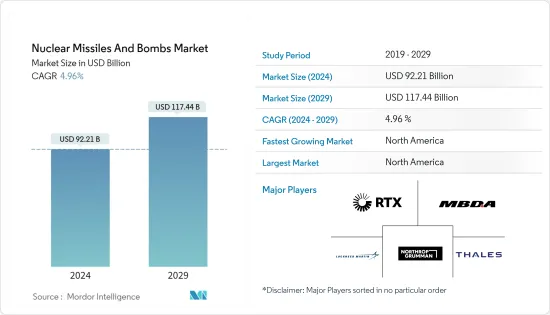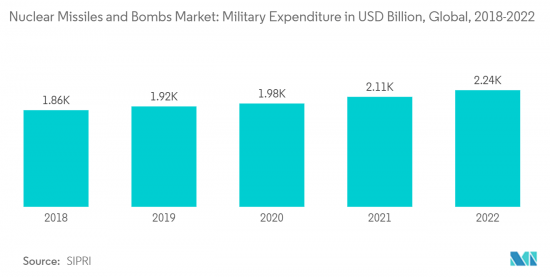
|
시장보고서
상품코드
1404418
핵미사일 및 핵폭탄 : 시장 점유율 분석, 산업 동향 및 통계, 성장 예측(2024-2029년)Nuclear Missiles And Bombs - Market Share Analysis, Industry Trends & Statistics, Growth Forecasts 2024 - 2029 |
||||||
핵미사일 및 핵폭탄(Nuclear Missiles And Bombs) 시장 규모는 2024년 922억 1,000만 달러로 추정되며, 2029년 1,174억 4,000만 달러에 이를 것으로 예측되며, 예측기간(2024-2029년)의 CAGR은 4.96%로 추이하며 성장 할 것으로 예측됩니다.

초음속 미사일 기술의 발전과 함께 국경 안보 문제와 테러 증가로 인한 다양한 국가의 군사비 지출 증가와 위협 증가는 시장 성장을 주도 할 것으로 예상되는 주요 요인입니다. 기업들은 핵미사일 및 핵폭탄 시장의 주요 개발 전략으로 대서양위원회, 브루킹스 연구소, 카네기 국제평화재단과의 협력, 장기 계약, 합작 투자, 협회 등을 채택하고 있습니다. 그러나 핵무기 사용을 금지하기위한 핵무기 금지 조약은 예측 기간 동안 시장 성장을 제한 할 수 있습니다.
핵미사일 및 핵폭탄 시장 동향
핵미사일
핵미사일 분야는 폭탄에 대한 미사일의 우위와 방위비 증가로 시장 점유율을 이끌 것으로 예상됩니다. 스톡홀름 국제 평화 연구소(SIPRI)에 따르면 2022년 전 세계 군사비는 2조 2,400억 달러로 2021년 전 세계 군사비보다 3.7% 증가했습니다. 국방 예산의 증가는 각국이 전투 능력을 강화하고 계획대로 국방 전략을 실행하는 데 도움이 될 것입니다. 핵미사일은 핵폭탄과는 달리 최대 수천 마일에 이르는 광범위한 작전 범위를 가지고 있습니다. 또한 핵미사일은 원격으로 작동할 수 있으므로 무기를 발사하는 사람이 폭발 후 물리적 또는 방사능 영향을 받지 않습니다. 하지만 조종사가 폭탄 가까이에 있는 핵폭탄의 경우에는 그렇지 않을 수 있습니다. 핵폭탄이 무인 항공기를 통해 투하된다고 가정해 보겠습니다. 이 경우 현대식 방공망을 뚫고 적진에 핵폭탄을 투하할 수 있을 만큼 생존력이 있어야 하는데, 이는 현재 소수의 항공기만이 할 수 있는 일입니다. 이러한 장점으로 인해 현재 핵미사일 부문의 개발 및 조달이 활발히 이루어지고 있습니다.

북미가 가장 높은 성장을 이룰 전망
북미는 미국의 핵무기 프로그램에 대한 예산 배분이 증가함에 따라 예측 기간 동안 시장 성장을 주도 할 것으로 예상됩니다. 의회예산국(CBO)은 2021년 5월 미국이 향후 10년간 핵무기를 유지하고 현대화하기 위해 총 6,340억 달러를 지출할 것으로 예상했는데, 이는 2019년에 발표한 이전 10년 전망치보다 28% 증가한 수치입니다. 또한, 미국의 핵탄두 및 폭탄 비축량은 국가안보국의 수명 연장 프로그램(LEP)을 통해 지속적으로 개량되고 있습니다. 기존 탄두는 매년 안전성과 신뢰성을 인증받습니다. NNSA는 현재 비축된 거의 모든 유형의 탄두를 개조하거나 교체하기 위해 논란이 많고 비용이 많이 드는 계획을 추진 중입니다. 2021년 현재 지상에 배치된 미국 핵전력은 공군 글로벌 스트라이크 사령부가 운용하는 450개의 발사대에 배치된 400기의 미니트맨 III ICBM으로 구성되어 있습니다. 바다에 있는 핵전력은 14척의 핵추진 오하이오급 트라이던트 잠수함(태평양에 9척, 대서양에 5척)으로 구성되어 있습니다. 공중에서는 60대의 핵 탑재 중폭격기, 20대의 B-2 폭격기, 40대의 B-52 폭격기가 핵 능력을 제공합니다. 이러한 발전은 예측 기간 동안 북미 시장 성장 전망을 주도 할 것입니다.
핵미사일 및 핵폭탄 산업 개요
핵미사일 및 핵폭탄 시장은 반고정적이며, 소수의 진출기업이 시장 점유율을 차지하고 있습니다. MBDA, RTX Corporation, Lockheed Martin Corporation, Northrop Grumman Corporation 및 THALES는 시장에서 유명한 진출기업의 일부입니다. 이 시장의 진출기업은 보다 빠르고 살상력이 높은 첨단 미사일의 개발에 주력하고 있으며, 이로써 군과 새로운 계약을 획득하고 있습니다. 따라서 첨단 방공 시스템을 관통할 수 있는 극초음속 핵 탑재 미사일의 개발에 초점을 맞추고 있으며, 주요 방위 관련 기업은 현재 이러한 기술의 개발을 위해 노력하고 있습니다. 진출기업 간 파트너십은 기술 이전을 촉진하고 예측 기간 동안 진출기업의 성장을 지원합니다.
기타 혜택 :
- 엑셀 형식 시장 예측(ME) 시트
- 3개월간 애널리스트 서포트
목차
제1장 서론
- 조사 전제 조건
- 조사 범위
제2장 조사 방법
제3장 주요 요약
제4장 시장 역학
- 시장 개요
- 시장 성장 촉진 요인
- 시장 성장 억제 요인
- Porter's Five Forces 분석
- 공급기업의 협상력
- 구매자·소비자의 협상력
- 신규 참가업체의 위협
- 대체품의 위협
- 경쟁 기업간 경쟁 관계의 강도
제5장 시장 세분화
- 유형
- 핵미사일
- 핵폭탄
- 미사일 사정거리
- 1,000km 미만
- 1,000-5,000km
- 5,000km 초과
- 지역
- 북미
- 유럽
- 아시아 태평양
- 기타
제6장 경쟁 구도
- 벤더의 시장 점유율
- 기업 개요
- MBDA
- RTX Corporation
- Lockheed Martin Corporation
- Northrop Grumman Corporation
- THALES
- The Boeing Company
- Rafael Advanced Defense Systems Ltd.
- Tactical Missiles Corporation
- BAE Systems plc
- Safran SA
- Aerojet Rocketdyne
- General Dynamics Corporation
제7장 시장 기회 및 향후 동향
LYJ 24.01.25
The Nuclear Missiles And Bombs Market size is estimated at USD 92.21 billion in 2024, and is expected to reach USD 117.44 billion by 2029, growing at a CAGR of 4.96% during the forecast period (2024-2029).
The increasing military expenditure and the rising threats for various nations due to border security issues and the growing terrorism, along with the advancements in hypersonic missile technologies are the major factors anticipated to drive the growth of the market. Companies have adopted collaboration, long-term agreements, joint ventures, and associations with the Atlantic Council, Brookings Institution, and Carnegie Endowment for International Peace as their key development strategies in the nuclear bombs and missiles market. However, the treaty on the prohibition of nuclear arms, which is intended to prohibit the use of nuclear weapons, may restrain the market growth during the forecast period.
Nuclear Missiles And Bombs Market Trends
Nuclear Missiles
The nuclear missiles segment is expected to lead the market share owing to the advantages of missiles over bombs and rising defense expenditures. According to the Stockholm International Peace Research Institute (SIPRI), the global military expenditure in 2022 was USD 2,240 billion, which was 3.7% higher than the global military expenditure in 2021. The growth in defense budgets will support the nations to enhance their combat capabilities and help them execute their defense strategies as planned. Nuclear missiles have a wide range of operations, ranging up to thousands of miles, which is not the case with gravity bombs. Also, nuclear missiles can be operated remotely so that the person launching the weapon does not have any physical or radiational effect following the blast. This may not be the case with gravity-dropped bombs, in which the pilot will be in near vicinity to the bomb. Suppose the gravity bombs are dropped by means of a UAV. In that case, it must be survivable enough to penetrate modern air defenses and drop nuclear gravity bombs on the enemy territory, which is something only a few aircraft are currently capable of. Due to such advantages, the development and procurement of the nuclear missiles segment are currently high.

North America is Expected to Witness Highest Growth
North America is expected to lead the market growth during the forecast period owing to the increase in budget allocation for nuclear weapons programs in the US. The Congressional Budget Office (CBO) estimated in May 2021 that the US will spend a total of USD 634 billion over the next 10 years to sustain and modernize its nuclear arsenal, which is 28 percent higher than the previous 10-year projection released in 2019. Also, the US stockpile of nuclear warheads and bombs is continually refurbished through NNSA's Life Extension Program (LEP). Existing warheads are certified annually to be safe and reliable. The NNSA is currently pursuing a controversial and expensive plan to refurbish or replace nearly every warhead type in the stockpile. As of 2021, American nuclear forces on land consist of 400 Minuteman III ICBMs spread among 450 operational launchers staffed by Air Force Global Strike Command. Those in the seas consist of 14 nuclear-capable Ohio-class Trident submarines, nine in the Pacific and five in the Atlantic. Nuclear capabilities in the air are provided by 60 nuclear-capable heavy bombers, 20 B-2 bombers, and 40 B-52s. Such developments will drive the growth prospects of the market in North America during the forecast period.
Nuclear Missiles And Bombs Industry Overview
The nuclear missiles and bombs market is semi-consolidated, with a handful of players owning the market share. MBDA, RTX Corporation, Lockheed Martin Corporation, Northrop Grumman Corporation, and THALES are some of the prominent players in the market. Players in the market are focusing on developing advanced missiles with higher speeds and lethality, which will help them gain new contracts with the militaries. As such, the focus on developing hypersonic nuclear-capable missiles that can penetrate advanced air defense systems has increased, with the major defense contractors currently working towards developing such technologies. Partnerships among players will facilitate technology transfer, thereby helping the growth of the players during the forecast period.
Additional Benefits:
- The market estimate (ME) sheet in Excel format
- 3 months of analyst support
TABLE OF CONTENTS
1 INTRODUCTION
- 1.1 Study Assumptions
- 1.2 Scope of the Study
2 RESEARCH METHODOLOGY
3 EXECUTIVE SUMMARY
4 MARKET DYNAMICS
- 4.1 Market Overview
- 4.2 Market Drivers
- 4.3 Market Restraints
- 4.4 Porter's Five Forces Analysis
- 4.4.1 Bargaining Power of Suppliers
- 4.4.2 Bargaining Power of Buyers/Consumers
- 4.4.3 Threat of New Entrants
- 4.4.4 Threat of Substitute Products
- 4.4.5 Intensity of Competitive Rivalry
5 MARKET SEGMENTATION
- 5.1 Type
- 5.1.1 Nuclear Missiles
- 5.1.2 Gravity Bombs
- 5.2 Missile Range
- 5.2.1 Less than 1000km
- 5.2.2 1000km - 5000km
- 5.2.3 Greater than 5000km
- 5.3 Geography
- 5.3.1 North America
- 5.3.2 Europe
- 5.3.3 Asia-Pacific
- 5.3.4 Rest of the World
6 COMPETITIVE LANDSCAPE
- 6.1 Vendor Market Share
- 6.2 Company Profiles
- 6.2.1 MBDA
- 6.2.2 RTX Corporation
- 6.2.3 Lockheed Martin Corporation
- 6.2.4 Northrop Grumman Corporation
- 6.2.5 THALES
- 6.2.6 The Boeing Company
- 6.2.7 Rafael Advanced Defense Systems Ltd.
- 6.2.8 Tactical Missiles Corporation
- 6.2.9 BAE Systems plc
- 6.2.10 Safran SA
- 6.2.11 Aerojet Rocketdyne
- 6.2.12 General Dynamics Corporation







